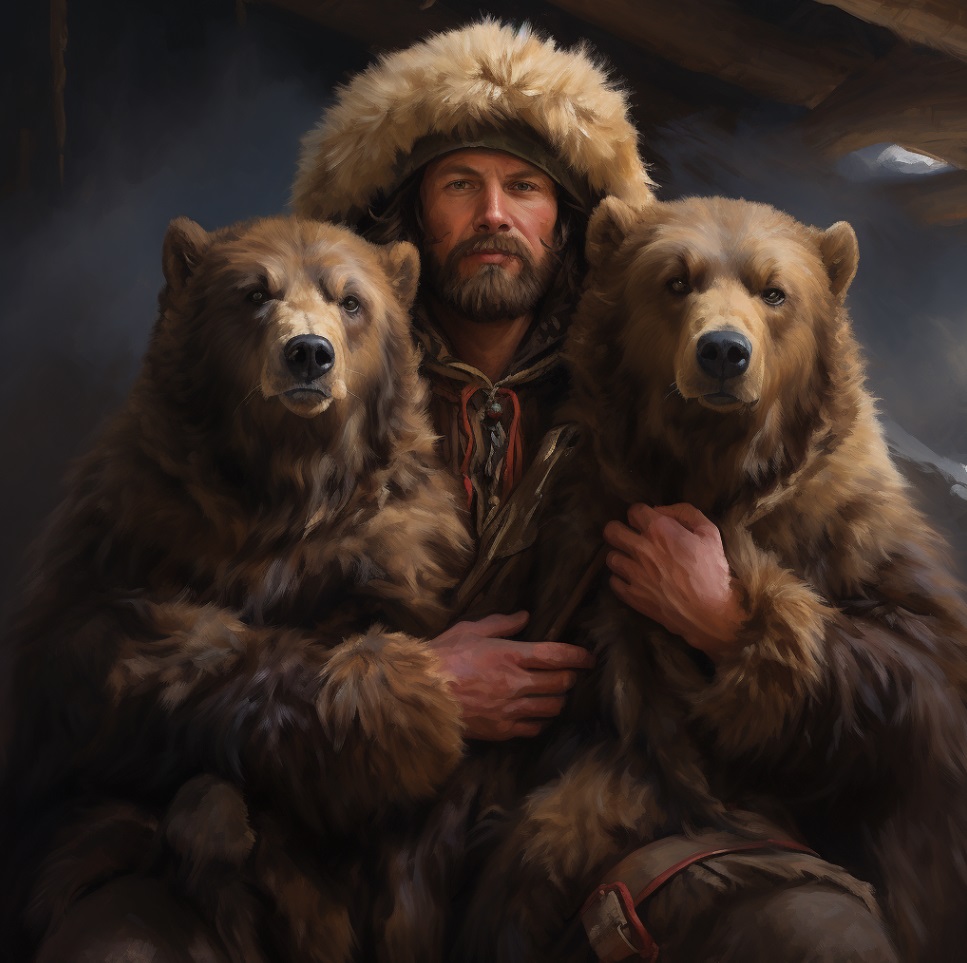
John "Grizzly" Adams: Forging the American Legend, One Bear at a Time
America’s landscape is not merely etched with mountains and rivers, but also with the indelible narratives of its legends. These are tales of audacious individuals who, through extraordinary deeds or sheer force of will, transcended the mundane to become archetypes of the American spirit. From the pioneering resilience of Daniel Boone to the industrial ambition of Henry Ford, these figures embody the nation’s evolving identity. Yet, few encapsulate the raw, untamed essence of the American wilderness and the curious human spirit of reinvention quite like John "Grizzly" Adams. His story, a potent blend of truth, exaggeration, and outright myth, offers a fascinating lens through which to examine the very fabric of American legend-making.
Born James Capen Adams in 1812 in Medway, Massachusetts, the man who would become "Grizzly" Adams seemed destined for a life far removed from the roaring grizzlies and vast wilderness he would later tame. His early years were marked by a series of apprenticeships – a shoemaker, a merchant, a general store owner. He was a family man, seemingly content with the quiet rhythms of settled life. But beneath this veneer of normalcy pulsed a restless energy, an innate longing for something more primal, more challenging than the burgeoning industrial society of the East. The call of the wild, and perhaps the lure of a fresh start, proved irresistible.
The pivotal moment that irrevocably steered James Adams towards his legendary destiny occurred in 1849. In a violent altercation, Adams killed his landlord, Charles Booth, allegedly in self-defense during a dispute over a debt. Facing a murder charge, Adams fled. This act of flight wasn’t merely an escape from justice; it was a profound severance from his past, a shedding of his old identity. He journeyed westward, following the tide of the California Gold Rush, but his quest wasn’t for gold. It was for solitude, for sanctuary, and ultimately, for transformation. He sought refuge in the Sierra Nevada mountains, a vast, untamed expanse that would become both his forge and his stage.

It was in these rugged, unforgiving mountains that James Capen Adams died, and John "Grizzly" Adams was born. Here, he didn’t just survive; he thrived. He became a master frontiersman, learning the ways of the wilderness with an intensity that bordered on obsession. He hunted, trapped, and lived off the land, his reputation growing among the sparse settlements as a man who understood the wild on its own terms. But what truly set Adams apart was not just his survival skills, but his astonishing ability to interact with the most formidable creatures of the American West: the grizzly bear.
Unlike other hunters who sought to conquer and kill, Adams sought to understand and, remarkably, to coexist. He captured bear cubs, often after killing their mothers in necessary defense, and painstakingly raised them. He trained them not through cruelty, but through patience and a deep, almost mystical connection. His most famous companions included "Ben Franklin," a formidable grizzly who would accompany Adams on his travels, and "Samson," another giant bear known for his strength and Adams’s incredible control over him. These were not mere pets; they were partners, companions in his solitary existence, and living testaments to his unique rapport with nature.
Accounts from those who encountered Adams during these years speak of a man whose appearance mirrored the wildness he embraced. He was often described as gaunt, with a long, unkempt beard, clad in buckskins, and always accompanied by his ursine retinue. He became a living embodiment of the "wild man" archetype, a figure straddling the line between human civilization and primeval nature. This period was not without its dangers; Adams sustained numerous injuries from his animal companions, including a particularly severe head injury from a grizzly that would plague him for the rest of his life. Yet, these scars only deepened his legend, proof of his intimate, perilous dance with the wild.
By the mid-1850s, the lure of the wilderness began to wane, or perhaps the need for financial stability grew too strong. Adams, the master of survival, realized there was a new kind of frontier to conquer: the burgeoning American appetite for spectacle. He moved to San Francisco, bringing his menagerie of bears, wolves, and other wild animals. Here, he established "Adams’s California Menagerie," a unique exhibition that showcased his extraordinary animal-taming skills. He would perform daring feats, wrestling with his grizzlies, riding them, and demonstrating their surprising docility under his command.
His performances were a sensation. The public, increasingly removed from the untamed wilderness, was captivated by this genuine frontiersman who seemed to command the very beasts of the forest. Adams understood the power of a good story, and he was a natural showman. He spun tales of his adventures, embellishing facts and crafting a persona that was part rugged naturalist, part heroic bear-tamer. He was, in essence, an early American performance artist, blurring the lines between reality and entertainment.
It was this growing fame that caught the attention of the ultimate impresario of the age, P.T. Barnum. Barnum, always on the lookout for the next great sensation, saw in Adams a golden opportunity. In 1860, despite Adams’s declining health from his numerous injuries, Barnum brought him and his menagerie to New York City. He rechristened Adams "The Great California Hunter and Grizzly Bear Tamer" and made him a star attraction at his American Museum. Barnum, a master of hyperbole, advertised Adams as a man of unparalleled courage, a living relic of the wild West, and a testament to man’s dominion over nature.
Barnum famously remarked of Adams: "He was a rough specimen of humanity, but a man of considerable natural intelligence, and possessed of a kind heart. His life had been one of daring adventure, and he was covered with scars, the results of his encounters with wild beasts." This quote, whether entirely accurate or partially a Barnum-esque embellishment, perfectly captured the public’s perception of Adams: a man forged by the wilderness, bearing its marks with pride.
Adams’s performances in New York were wildly successful, but his health continued to deteriorate. The head injury, combined with years of arduous living and other untreated wounds, took its toll. Despite the pain, Adams continued to perform, driven by a desire to provide for his family and a deep-seated commitment to his animals. He died in October 1860, just months after arriving in New York, and was buried in his hometown in Massachusetts. His last wish, reportedly, was that his beloved bears be well cared for.

John "Grizzly" Adams’s life story is a quintessential American legend because it embodies so many core themes of the national identity. He represents the rugged individualism that drove pioneers westward, the belief that a man could forge his own destiny, even against the backdrop of an unforgiving wilderness. He personifies the frontier spirit, the adventurous courage to confront the unknown and carve a life out of raw nature. His unique relationship with animals speaks to a deeper American fascination with the wild, a romantic ideal of man living in harmony, or at least in respectful proximity, with the natural world.
Beyond these thematic elements, Adams’s legend also highlights the American propensity for self-reinvention. James Capen Adams, the humble shoemaker, transformed himself into Grizzly Adams, the legendary bear-tamer. This ability to shed an old identity and create a new one, particularly when escaping a troubled past, is a powerful and enduring motif in American lore. It speaks to the promise of a fresh start, a clean slate, offered by the vastness of the continent.
Furthermore, Adams’s story is a testament to the power of myth-making. While his skills were undoubtedly real and his life genuinely adventurous, P.T. Barnum and the public imagination amplified his exploits into something larger than life. The lines between man and legend became irrevocably blurred. What truly matters in the creation of a legend is not just the verifiable facts, but the resonant truth the story conveys about a culture’s values and aspirations. Grizzly Adams, with his bear companions and wild demeanor, became a symbol of a vanishing frontier, a romanticized representation of a time when man and nature were in direct, often perilous, dialogue.
His legacy extends far beyond the 19th century. The legend of Grizzly Adams was revived and popularized in the 1970s with a hit movie, "The Life and Times of Grizzly Adams," and a subsequent television series starring Dan Haggerty. These adaptations further cemented his image as a gentle giant, a friend to animals, and a symbol of ecological harmony – a version of the legend perhaps more palatable to a modern audience, but still rooted in the real man who walked the Sierra Nevadas with bears by his side.
In conclusion, John "Grizzly" Adams stands as a towering figure in the pantheon of American legends. His life was a complex tapestry woven with threads of escape, survival, profound connection to nature, and the ultimate triumph of showmanship. He was a man who literally wrestled with his demons and with grizzlies, who escaped a murder charge only to embrace a new identity forged in the heart of the wilderness. His journey from an ordinary shoemaker to a celebrated bear-tamer, immortalized by Barnum and later by Hollywood, reflects the dynamic interplay between truth and fiction that defines so many American myths. More than just a man, Grizzly Adams became an enduring symbol of the untamed American spirit, a testament to the allure of the wild, and the captivating power of a truly legendary life.


